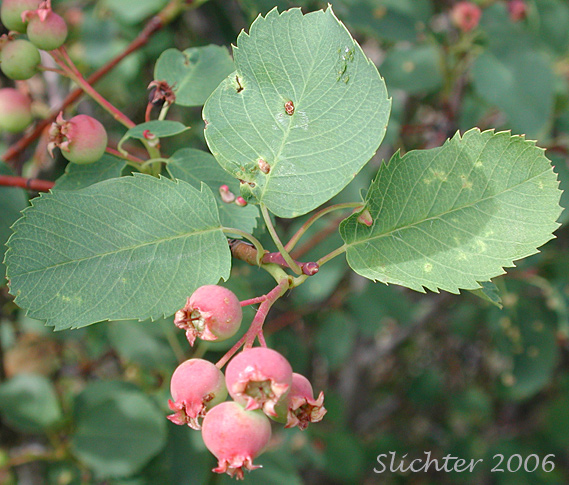
Amelanchier alnifolia

Serviceberry is an attractive low-spreading shrub or erect, small tree from 1-7 meters high. The young branches and buds are reddish brown and smooth while the older twigs are gray. The leaves are alternate on short stalks off of the stems. They are bright green in color and oval to elliptic in shape, ranging from 2-4 cm long. The margins are entire on the lower half and toothed on the distal half (See photo at right.).
The flowers are plentiful, fragrant, and grouped in showy white clusters or racemes of 3-20 flowers. Individual flowers are 2-3 cm across with 5 thin, often twisted white petals and about 20 stamens. The fruits are globose, fleshy with several seeds, and initially red, later ripening to dark purple.
Western Serviceberry, Saskatoon Serviceberry: Amelanchier alnifolia var. alnifolia -
Cusick's Serviceberry: Amelanchier alnifolia var. cusickii -
Dwarf Serviceberry: Amelanchier alnifolia var. pumila -
Pacific Serviceberry, Western Serviceberry: Amelanchier alnifolia var. semiintegrifolia (Synonyms: Amelanchier alnifolia var. florida, Amelanchier canadensis var. semiintegrifolia, Amelanchier ephemerotricha, Amelanchier ephemerotricha var. silvicola, Amelanchier florida, Amelanchier florida var. florida, Amelanchier florida va. parvifolia, Amelanchier florida var. tomentosa, Amelanchier gormani, Amelanchier ovalis var. semiintegrifolia, Amelanchier oxyodon, Amelanchier parvifolia, Amelanchier vestita) -
The berries are edible and tasty. They are a good source of iron and copper. Native Americans ate the berries raw or dried them into loaves for later use in soups and stews, or mixed with meat and fat for travel food (pemmican?). Native Americans also used the wood for arrows, spears, and crosspieces for canoes. The juice of the berries was used as a dye. The berries are used today in jams, jellies, and wines. The leaves and stems are browsed by deer, elk, sheep and goats. Grouse eat the berries during the summer and the buds during the winter. Serviceberry is also useful as an ornamental plant.
Serviceberry may be found in open woods, canyons, and hillsides from sea level to subalpine habitats. It is especially fond of rocky soils.
Serviceberry may be found from southern Alaska south to California and east to Alberta. It is found southward at the east part of its range through the Dakotas, Nebraska, Colorado, New Mexico and Arizona.
In the Columbia River Gorge, it may be found between the elevations of 100'-4300' throughout the length of the gorge.